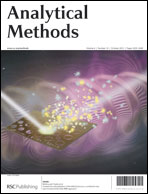Well-redispersed ceria nanoparticles: Promising peroxidase mimetics for H2O2 and glucose detection
Abstract
Well-redispersed ceria nanoparticles (CeO2 NPs) were synthesized by a simple hydrothermal method. The prepared CeO2 NPs exhibited excellent catalytic activity towards classical peroxidase substrate 3,3,5,5-tetramethylbiphenyl dihydrochloride (TMB·2HCl) in the presence of H2O2, based on which a colorimetric method that is highly sensitive and selective was developed for glucose detection. The composition, structure, morphology and peroxidase-like catalytic activity of CeO2 NPs are investigated in detail by using X-ray diffraction (XRD), transmission electron microscopy (TEM), high resolution transmission electron microscopy (HRTEM), selected area electron diffraction (SAED), X-ray photoelectron spectroscopy (XPS), Fourier transform infrared spectrometer (FT-IR), thermal analysis (TG) and UV-vis absorption spectroscopy. According to this method, the detection of H2O2 and glucose are in linear range from 6.0 × 10−7 to 1.5 × 10−6 mol L−1 and 6.6 × 10−6 to 1.3 × 10−4 mol L−1, with the detection limit down to 5.0 × 10−7 mol L−1 H2O2 and 3.0 × 10−6 mol L−1 glucose, respectively. Further, this simple, cheap, highly sensitive and selective colorimetric method for glucose detection was successfully applied for the determination of glucose in human serum samples.


 Please wait while we load your content...
Please wait while we load your content...